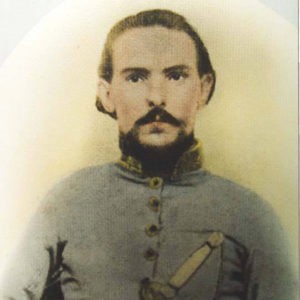calsfoundation@cals.org
Eleventh Arkansas Infantry (CS)
The Eleventh Arkansas Infantry Regiment was a Confederate unit that served in the Western Theater during the American Civil War. The regiment was enrolled on July 9, 1861, in Benton (Saline County) by Brigadier General George M. Holt, Arkansas State Militia. Composed of companies and men primarily from Saline County (Companies A, B, D, F, I, and K), the regiment had additional companies from Ouachita, Hot Spring, Columbia, and Hempstead counties. The elected colonel was Jabez M. Smith of Benton, a merchant and lawyer.
The regiment proceeded to Memphis, Tennessee, and later to Fort Pillow, Island No. 10, and finally New Madrid, Missouri. There, it garrisoned at Fort Thompson, along with the Twelfth Arkansas Infantry, and operated as pickets in front of New Madrid. In March 1862, Union forces under Brigadier General John Pope began operations to implement a siege against New Madrid. By early March, with his guns in position, Pope opened the first artillery attack on New Madrid. Brigadier General John P. McCown decided to evacuate New Madrid on March 13 and relocated the regiment to protect Watson’s Battery on the east bank of the Mississippi River. Union gunboats passed Island No. 10 on April 4–6, forcing a Confederate retreat. Finding that Pope’s forces had crossed and cut them off to the south, the entire Confederate force was surrendered on April 8, 1862. Men of the Eleventh Arkansas were sent to northern military prisons, primarily Camp Douglas, Illinois; Camp Butler, Illinois; and Johnson’s Island, Ohio.
Upon release from prison, the regiment was paroled and exchanged at Vicksburg, Mississippi, and reorganized under command of Colonel John L. Logan, former captain of Company G. In March 1863, it was consolidated with the Seventeenth Arkansas Infantry, mounted, and designated as the Eleventh and Seventeenth Consolidated Mounted Infantry. The consolidated regiment served the remainder of the war in the Department of Mississippi and East Louisiana.
In April 1863, the unit was ordered to head off the raid of Union colonel Benjamin Grierson but was unsuccessful. Later, it operated outside the fortifications of Port Hudson until the surrender of that garrison on July 9, 1863. While engaged in numerous battles during the Port Hudson campaign (Plains Store, Bayou Sara, and Clinton, Louisiana), the regiment captured Brigadier General Neal Dow, who was later used as an exchange for Brigadier General W. H. F. “Rooney” Lee, the son of General Robert E. Lee. After the surrender of the garrison, men of the regiment who were captured during the campaign were paroled and sent back to Arkansas. Many of these later served in Arkansas as part of Poe’s Battalion, also referred to as the Eleventh Arkansas Cavalry.
On August 3, 1863, the regiment mounted a successful attack on Union forces at Jackson, Louisiana, routing them into a hasty retreat. Later, it was redirected into central Mississippi, where it opposed Union forces operating out of Vicksburg. October 16–18 found the regiment fighting against a larger Union command near Brownsville, Mississippi, with battles at Catlett’s and Treadwell’s plantations along Bogue Chitto Creek, and Robinson’s Mill at Livingston, Mississippi.
In November, Colonel Logan transferred to Arkansas, and the command of the regiment passed to Colonel John Griffith. In February 1864, the regiment participated in the defense of central Mississippi during Major General William Sherman’s Meridian Campaign. In numerous small skirmishes, the regiment fell back before Sherman’s force, which returned to Vicksburg after inflicting devastating damage on Meridian and all communities in its path.
In April 1864, a detachment of the regiment succeeded in capturing the USS Petrel near Yazoo City, Mississippi, taking all its armaments and burning it to the water line. The remainder of the year, it operated extensively throughout central and southern Mississippi, performing scouting missions and raids on unsuspecting Union forces. On December 2, 1864, the regiment successfully thwarted a raid on Jackson, Mississippi, near Yazoo City at Concord Church. A month later, on January 2, 1865, the regiment met the Third U.S. Colored Cavalry commanded by Colonel Emory Osband near Franklin Church, Mississippi. This unit was part of a larger force conducting a raid from Memphis to Vicksburg. After sustained heavy fighting, the Confederates forced the Union cavalry to withdraw to the west and rejoin its main column.
The regiment saw little fighting for the remainder of the war, with its last skirmish on January 4, 1865, at The Ponds, Mississippi. Stationed in southern Mississippi when the department was surrendered at Citronella, Alabama, on May 4, 1865, most members of the regiment surrendered and were paroled at Jackson, Mississippi, on May 13, 1865.
For additional information:
Daniel, L. J., and L. N. Bock. Island No. 10: Struggle for the Mississippi Valley. Tuscaloosa: University of Alabama Press, 1996.
Foster, Buck. Sherman’s Mississippi Campaign. Tuscaloosa: University of Alabama Press, 2006.
Lide, J. E. “The Eleventh Arkansas Regiment.” Ouachita County Historical Quarterly 9 (June 1978): 10–12.
Poe, J. C., comp. and ed. The Raving Foe: The Civil War Diary of Major James T. Poe, C.S.A., and the 11th Arkansas Volunteers, and a Complete List of Prisoners. Eastland, TX: Longhorn Press, 1967.
Rushing, Anthony C. Ranks of Honor: A Regimental History of the Eleventh Arkansas Infantry Regiment and Poe’s Cavalry Battalion, C.S.A., 1861–1865. Little Rock: Eagle Press, 1990.
The War of the Rebellion: A Compilation of the Official Records of the Union and Confederate Armies. Washington DC: Government Printing Office, 1880–1901.
Anthony Rushing
Benton, Arkansas
 Civil War through Reconstruction, 1861 through 1874
Civil War through Reconstruction, 1861 through 1874 Military
Military Twelfth Arkansas Infantry (CS)
Twelfth Arkansas Infantry (CS) ACWSC Logo
ACWSC Logo  John L. Logan
John L. Logan  Jabez M. Smith
Jabez M. Smith 




Comments
No comments on this entry yet.